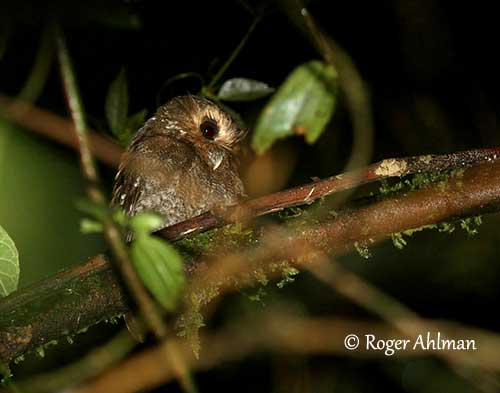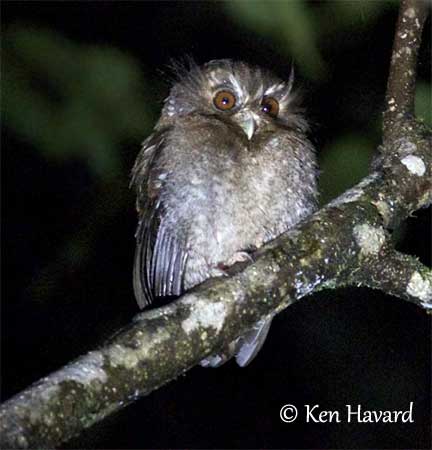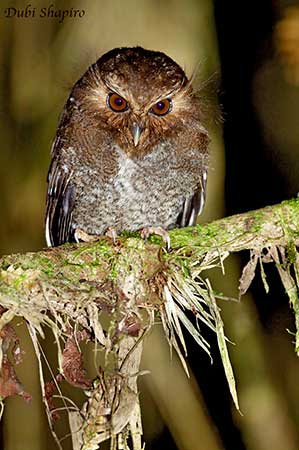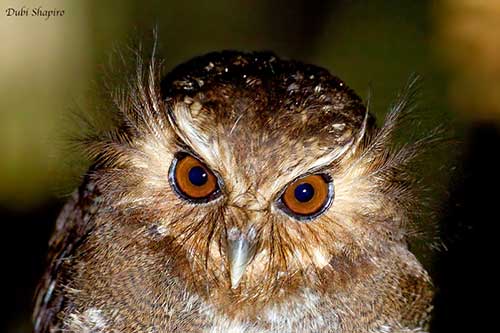
Fr: Chevêchette nimbée
Ang: Long-whiskered Owlet
All: Peruanerkauz
Esp: Mochuelo Peludo
Esp: Pérou - Peru: Lechucita Bigotona
Ita: Civetta baffuta
Nd: Snorrebaarduil
Sd: borstuggla
Photographers :
Roger Ahlman
Pbase Galleries Peru and Ecuador
Ken Havard
My Bird Gallery & Flickr gallery 1 & Flickr gallery 2
Dubi Shapiro
Dubi Shapiro Photo Galleries
Text by Nicole Bouglouan
Sources :
HANDBOOK OF THE BIRDS OF THE WORLD Vol 5 by Josep del Hoyo-Andrew Elliott-Jordi Sargatal - Lynx Edicions - ISBN: 8487334253
OWLS OF THE WORLD – By Claus König, Friedhelm Weick and Jan-Hendrik Becking - IBSN 978-0-7136-6548-2
Neotropical Birds – Cornell Lab of Ornithology
THE AVIANWEB - Beauty of Birds (Sibylle Faye)
Wikipedia, la enciclopedia libre
The Guardian - Mystery bird: Long-whiskered owlet, Xenoglaux loweryi
National Geographic News - "Strange Owl" Seen in Wild for First Time
Nota sobre la dieta de la Lechucita Bigotona, Xenoglaux loweryi en Yambrasbamba, Amazonas
Alejandro Alarcón, Sam Shanee, Gabriela Huaman, Noga Shanee
Long-whiskered Owlet
Xenoglaux loweryi
Strigiformes Order – Strigidae Family
INTRODUCTION:
The Long-whiskered Owlet was not discovered until 1976. This small owlet does not resemble any other Strigidae in its morphology, and this species is the only member of the genus Xenoglaux. The name “Xenoglaux” means “strange owl” in Greek.
It is a very rare tiny bird, highly distinctive with surprisingly long facial whiskers, unique among owls. This species is known from only five specimens collected on the E slope of the Andes of Peru.
The Long-whiskered Owlet has extremely small range and the reduced suitable habitats are threatened by forest clearance and human development. This species is currently listed as Endangered.

BEHAVIOUR IN THE WILD:
The Long-whiskered Owlet has nocturnal habits and is mostly active at dusk.
Information about the behaviour of this species is lacking, but a study made in La Jalca (2,184 metres of elevation) in the Bangará province in Amazonas, Peru, presents the result of analysis of faecal samples.
This analysis revealed fragments of mandibles, eyes, fangs of several insect species such as Coleoptera, Hymenoptera, Orthoptera and Lepidoptera, and confirmed a similar diet to other small owlet species.
The breeding and nesting behaviour of the Long-whiskered Owlet is unknown. However, based on the behaviour of other small owlets of the tribe Surniini that includes the genera Surnia, Glaucidium, Xenoglaux, Micrathene and Athene, we can suggest some behavioural facts.
They are probably monogamous with long-term pair-bonds. The courtship displays of numerous owls include courtship feeding by male to female while she is giving begging calls. Mutual preening is common too.
The Long-whiskered Owlet appears to be resident within its reduced range.

This species has stubby wings and short tail. It has been suggested that this species may be almost flightless, but recent surveys have seen individuals in flight.
REPRODUCTION OF THIS SPECIES:
The Long-whiskered Owlet probably breeds when insect are abundant.
It probably nests in tree holes or other natural cavities in the humid montane forest. Both parents feed and tend the young.
PROTECTION / THREATS / STATUS:
The Long-whiskered Owlet has very restricted range in N Peru. Despite living in remote, dense mountain habitat, this species is threatened by the loss of suitable habitats.
The Long-whiskered Owlet is suffering rapid decline, due to the rapid destruction of the forest for timber and agriculture. In addition, road improvement, human population growth in the area and mining activities, contribute to habitat destruction.
The Long-whiskered Owlet is considered Endangered by Peruvian law, but the protected statuses appear to have had little effect on the rate of deforestation.
The population is probably very small and placed in the band 250/999 mature individuals, equivalent to 375/1,499 individuals. This population is suffering a serious decline due to continuation of forest destruction.
The Long-whiskered Owlet is currently listed as Endangered.
RANGE:
The Long-whiskered Owlet is found in South America, in a small area in N Peru, E of the Andes. It occurs in some places in C Amazonas and NW San Martín in N Peru.
HABITAT:
The Long-whiskered Owlet frequents the dense cloud forest in mountains, on isolated ridges at high elevation between 1,890 and 2,350 metres. It favours the humid forests with dense undergrowth, mosses, ferns and epiphytes.
CALLS AND SONGS: SOUNDS BY XENO-CANTO
The Long-whiskered Owlet gives a single short, deep whistle “gruw” usually repeated at intervals of 3-5 seconds. It can be heard at night, while uttering its repeated descending hoot.
It also gives a two-part vocalization including 3-5 similar whistles followed by a series of faster, higher-pitched notes. Maybe the male’s song? The bird is attracted by imitations of this presumed song.


DESCRIPTION OF THE BIRD:
Biometrics:
Length: 13-14 cm
Weight: 46-51 g
The Long-whiskered Owlet has warm brown upperparts, densely vermiculated dark brown to blackish from crown to uppertail-coverts. We can see a white subterminal spot on the outer web of the scapulars. The dull black primaries have small pale spots on the outer webs, whereas the inner webs show an irregular whitish area at the bases. The short tail is dull brown, with pale and dark mottling.
The underparts are similar, but there are numerous whitish vermiculations, especially towards the belly.
On the head, the facial disk is brown but not conspicuous. We can see several fan-like whiskers around the bill base, but there are longer ones on sides of facial disk, extending beyond the edge of the face. The white eyebrows are short.
The bill is greenish-grey with pale yellow tip, and pinkish-grey cere. The eyes are orange-brown to amber-orange, with blackish-brown eyelids. Legs and feet are flesh-pink and bare. The claws are horn-coloured.
Male and female are similar, but the juvenile is not described.